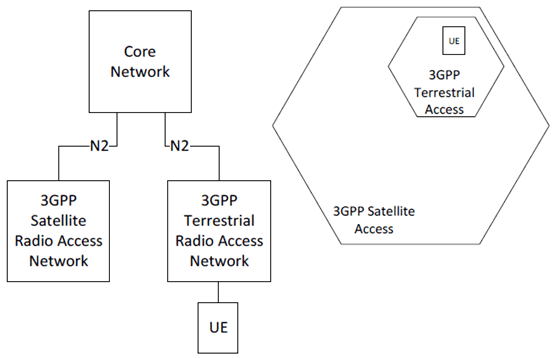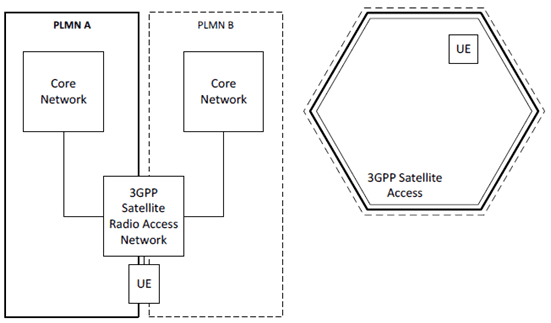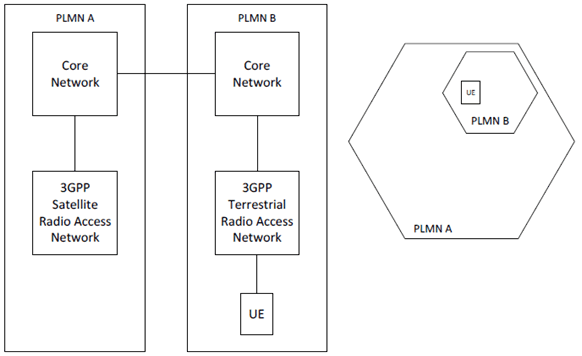Content for TR 23.737 Word version: 17.2.0
1 Scope
2 References
3 Definitions, symbols and abbreviations
3.1 Definitions
3.2 Abbreviations
4 Reference Satellite Integration Scenarios and Architectural Assumptions
4.1 Satellite access class scenarios
4.2 Satellite backhaul scenario
4.3 Architectural assumptions
...
...
1 Scope p. 9
The scope of this Technical Report is to study:
- The identification of impact areas of satellite integration in the 5GS, when considering TR 22.822 use cases.
-
The identification of solutions to adjust the 5G system for the impact impacts areas for the reference use cases:
- Roaming between terrestrial and satellite networks.
- 5G Fixed Backhaul between Satellite Enabled NR-RAN and the 5G Core.
- The resolution of RAN & CN inter-related issues.
2 References p. 9
The following documents contain provisions which, through reference in this text, constitute provisions of the present document.
- References are either specific (identified by date of publication, edition number, version number, etc.) or non specific.
- For a specific reference, subsequent revisions do not apply.
- For a non-specific reference, the latest version applies. In the case of a reference to a 3GPP document (including a GSM document), a non-specific reference implicitly refers to the latest version of that document in the same Release as the present document.
[1]
TR 21.905: "Vocabulary for 3GPP Specifications".
[2]
TR 22.822: "Study on using satellite access in 5G".
[3]
TS 23.502: "Procedures for the 5G System (5GS)".
[4]
TS 38.413: "NG-RAN; NG Application Protocol (NGAP)".
[5]
TR 23.793: "Study on access traffic steering, switch and splitting support in the 5G system architecture".
[6]
TR 23.501: "System architecture for the 5G System (5GS)".
[7]
TR 38.821: "Solutions for NR to support non-terrestrial networks (NTN)".
[8]
TS 22.011: "Service Accessibility".
[9]
TS 38.300: "NR; Overall description; Stage-2".
[10]
TS 23.122: "Non-Access-Stratum (NAS) functions related to Mobile Station (MS) in idle mode".
[11]
TS 23.041: "Technical realization of Cell Broadcast Service (CBS)".
3 Definitions, symbols and abbreviations p. 9
3.1 Definitions p. 9
For the purposes of the present document, the terms and definitions given in TR 21.905 and in TS 23.501 apply. A term defined in TS 23.501 takes precedence over the definition of the same term, if any, in TR 21.905 or in any other specifications.
3.2 Abbreviations p. 10
For the purposes of the present document, the abbreviations given in TR 21.905 and in TS 23.501 apply. An abbreviation defined in the present document takes precedence over the definition of the same abbreviation, if any, in TR 21.905, or in any other specifications.
ALM
Additive Layer Manufacturing
CDN
Content Distribution Network
CE
Coverage Enhancement
FIFO
First In First Out
gNB-CU
gNB-Centralized Unit
gNB-DU
gNB-Distributed Unit
GEO
Geostationary satellite Orbit
HEO
Highly-Eccentric-Orbit
HPA
High Power Amplifier
ISL
Inter-Satellite-Link
LEO
Low-Earth Orbit
LFU
Least Frequently Used
LRU
Least Recently Used
MEO
Medium-Earth Orbit
MOCN
Multi-Operator Core Network
NGSO
Non-Geostationary Satellite Orbit
NTN
Non Terrestrial Network
OBP
On-Board Processor
PDB
Packet Delay Budget
PSAP
Public Safety Answering Point
RTT
Round Trip Time
SAT
Satellite
sNB
satellite Node B.
SRI
Satellite Radio Interface
TER
Terrestrial
TTC
Telemetry, Tracking, and Command
WCRTT
Worst Case RTT
4 Reference Satellite Integration Scenarios and Architectural Assumptions p. 10
4.1 Satellite access class scenarios p. 10
4.1.1 Satellite and terrestrial access networks within a PLMN p. 10
A PLMN may have both terrestrial 3GPP access and satellite 3GPP access. In this scenario, separate N2 instances are handling separate access type nodes. However, the coverage of the satellite access network may span over the coverage of the terrestrial access network.

Figure 4.1.1-1: Satellite and terrestrial 3GPP access networks within a PLMN - architecture (left) and coverage (right)
(⇒ copy of original 3GPP image)
(⇒ copy of original 3GPP image)
4.1.2 PLMNs with shared satellite access p. 11
A satellite access network is shared between multiple core networks in a 5G Multi-Operator Core Network (MOCN) sharing architecture. In this case, the shared satellite Radio Access Network broadcasts system information for both PLMNs whose core networks are available. These PLMNs may also be with different Mobile Country Codes (MCCs).

Figure 4.1.2-1: Multi Operator Core Network sharing architecture with satellite radio access network architecture (left) and coverage (right)
(⇒ copy of original 3GPP image)
(⇒ copy of original 3GPP image)
4.1.3 Roaming and mobility between satellite only PLMN and terrestrial only PLMN p. 12
PLMNs are identified by a Mobile Country Code (MCC) and Mobile Network Code (MNC). Country codes that are actually country agnostic (90x) exist and have been on occasions assigned to satellite, air-aboard aircraft, maritime-aboard ships, Antarctica networks. Examples are Iridium - 90105, Thuraya 90106, etc.

Figure 4.1.3-1: Roaming and mobility between satellite and terrestrial PLMNs - architecture (left) and coverage (right)
(⇒ copy of original 3GPP image)
(⇒ copy of original 3GPP image)
4.2 Satellite backhaul scenario p. 12
A satellite backhaul is used between the core and terrestrial access network providing a transport for the N1/N2/N3 reference points. The satellite coverage plays no role as the satellite system transparently carries the communication payload of the 3GPP reference points.

4.3 Architectural assumptions p. 12
The following architectural assumptions are applied to all potential solutions:
- The 5GC shall be able to identify UEs which are accessing via satellite 3GPP access.
- A satellite access network is considered as a 3GPP access.
- Multi-connectivity over multiple N2 interfaces is not considered in this release.
- Ultra-Reliable Low Latency Communication (URLLC) over satellite is not considered in this release.